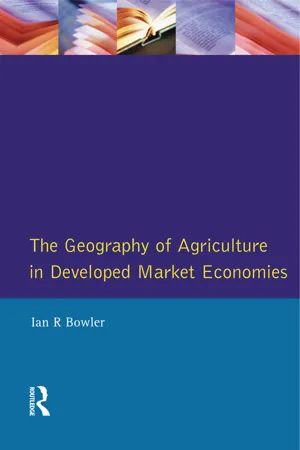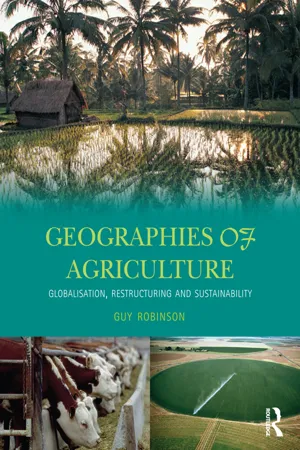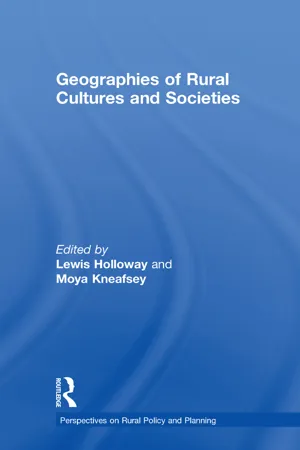Geography
Types of Agriculture
Types of agriculture include subsistence agriculture, commercial agriculture, intensive agriculture, extensive agriculture, and organic agriculture. Subsistence agriculture is for self-sufficiency, while commercial agriculture is for profit. Intensive agriculture involves high inputs and high yields, while extensive agriculture covers large areas with low inputs. Organic agriculture avoids synthetic inputs and focuses on sustainability.
Written by Perlego with AI-assistance
Related key terms
3 Key excerpts on "Types of Agriculture"
- I.R. Bowler(Author)
- 2014(Publication Date)
- Routledge(Publisher)
5Farm types and agricultural regions
John AitchisonThis and the following chapter examine the type-of-farm context for the contemporary transformation of agriculture. In this chapter attention is turned to the problems of classifying farm types and defining agricultural regions. Chapter 6 goes on to examine the changing enterprise structure of farm businesses.Like agricultural economists, who were among the first to develop farm classification (largely as a tool on which to base farm business advice), agricultural geographers have classified to satisfy a variety of objectives (Grigg 1969). Although the precise reasons for which individual classificatory studies have been carried out can be difficult to disentangle, often because they have not been explicity articulated, four overarching objectives can be distinguished.To present ordered information
Farms and farming regions form complex, dynamic systems. To appreciate their character, to track trends and changes, and to facilitate comparative analysis, such systems need to be classified. Classification serves a fundamental descriptive purpose; it filters information with a view to isolating meaningful patterns of ordered variation. Needless to say, for many agricultural geographers it is patterns of spatial or regional variation in types of farming that are of major interest. While they might be criticized for being too heavily descriptive, there is no doubting the fact that most taxonomic studies are at least factually informative. This is especially true of investigations carried out in less well-documented regions of the world, and in regions where previously uncharted developments in farming practices have taken place. This knowledge- generating role of classificatory inquiry should not be underrated.To seek explanations and to generate hypotheses
Patterns not only invite description, more importantly they invite explanation. In delimiting types-of-farming regions, for instance, agricultural geographers will normally endeavour to account for the spatial structures that emerge by citing the possible influence of particular processes or forces. Such factors include: soil conditions and climate; land, labour and capital availability; the size, demands and distance of relevant markets, including food processors; historical and cultural traditions; ideological constraints; systems of land tenure and the behavioural characteristics of farmers and growers.- eBook - ePub
Geographies of Agriculture
Globalisation, Restructuring and Sustainability
- Guy Robinson(Author)
- 2014(Publication Date)
- Routledge(Publisher)
2 The changing focus of agricultural geography2.1 ‘Traditional’ agricultural geographyThis chapter focuses on how the content of agricultural geography has evolved post-1945, thereby providing a context for the more extended consideration of key components of agricultural change in the rest of the book. Emphasis is placed upon how there has been a move from a ‘traditional’ form of agricultural geography to new approaches embracing different ideas from across the social sciences.A standard definition of agricultural geography in the mid-1980s referred to ‘the description and explanation of spatial variations in agricultural activity over the earth’s surface’ (Ilbery, 1985a, p. 1). This interpretation was based largely on consideration of two major avenues of enquiry that had dominated agricultural geography in the twentieth century:• Location and context, in which emphasis was placed on the regional characteristics of agricultural activities, especially broad trends and tendencies (Coppock, 1968; 1971).• Explanations of agriculture’s great diversity, through consideration of relationships between the large number of relevant variables associated with social, economic, physical and historical factors affecting agriculture (e.g. Grigg, 1992a).The regional focus in the first of these can be traced to the first time that a specialism specifically termed ‘agricultural geography’ played a leading role in the development of geography as an academic discipline. This was in the 1920s when agricultural geography was one of the principal specialisms that emerged as part of the growth of regional geography as the discipline’s central paradigm (Johnston, 1997, pp. 44–52). An example of this was Baker’s (1926) work on the recognition of ‘agricultural regions’ in different parts of the world. The region became the central focus of study for agricultural geographers, with both singleattribute and multi-attribute regions being recognised. Indeed, for the first half of the twentieth century agricultural geography involved regional delimitations following large-scale mapping of distributions of crops and livestock (e.g. Robertson, 1930) and the classification of agricultural systems (e.g. Whittlesey, 1936). Prevailing ideas on environmental determinisim emphasised the physical controls exerted upon the nature of agricultural activity. Description of agricultural variations was important, with land-use mapping of significance in some countries, a good example being the Land Utilisation Survey of Great Britain, begun in the 1930s by the geographer L. D. Stamp (1948). - eBook - ePub
- Moya Kneafsey, Lewis Holloway(Authors)
- 2017(Publication Date)
- Routledge(Publisher)
1. The scope of this paper is restricted to a particular geographical context (the UK) as this provides coherence through the particularities of the structure and organization of the farming and food industry, and those of the British academic community (institutional and career structures, research funding etc.). A geographical focus is also a means of making a review article manageable. This is not to deny the existence (and contribution) of non British ‘agri-cultural’ research in the developed market economies, conducted both by geographers and other social scientists, notably rural sociologists e.g. in the Wageningen School, and various researchers based in Northern Europe, Australasia and North America. Indeed, this work will be referred to in the review where it has provided inspiration to / influenced British research.2. None of the assertions made in this chapter are meant to imply that the cultural turn is all encompassing and has eclipsed other, more traditional approaches to and concerns of research in agriculture (or the rest of the rural for that matter). So, cultural geographies of agriculture are understood as having developed alongside traditional behavioural and political economic investigations of the sector and are by no means dominant.3. Evidenced by the relative balance of rural and agricultural papers presented at events hosted by the Rural Geography Study Group of the RGS-IBG and the Rural Economy and Society Study Group.4.
Learn about this page
Index pages curate the most relevant extracts from our library of academic textbooks. They’ve been created using an in-house natural language model (NLM), each adding context and meaning to key research topics.


